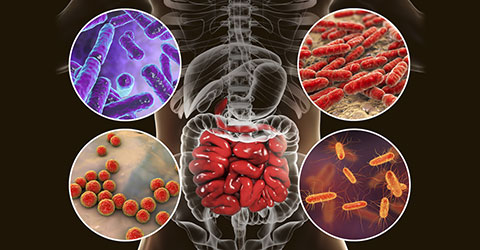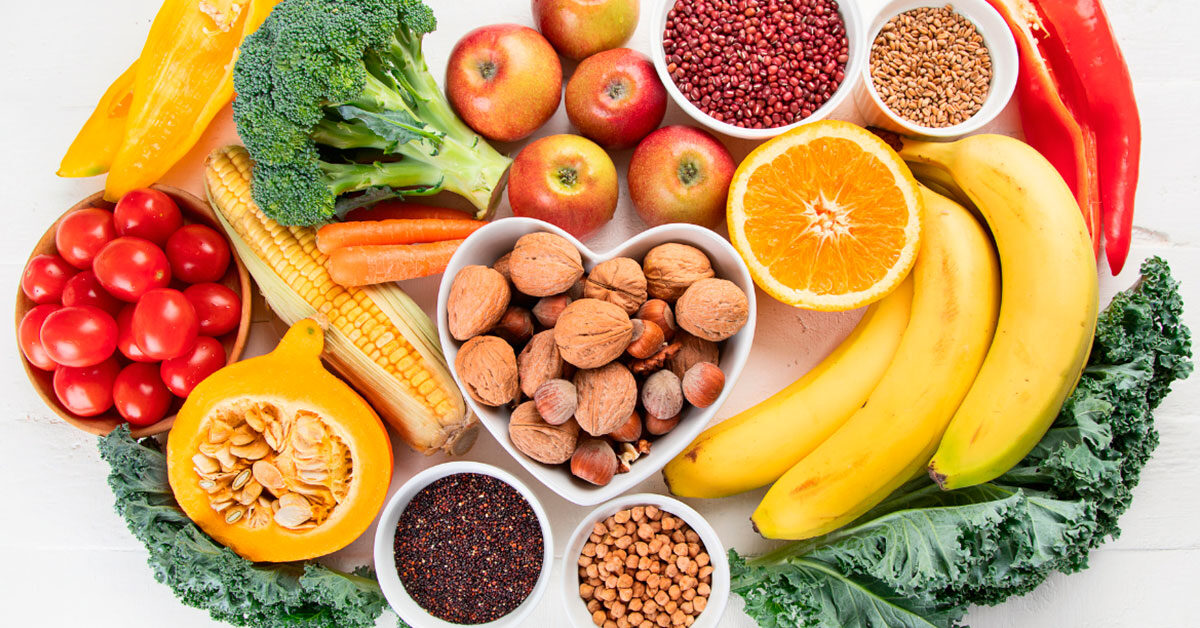

Everyone experiences bloating from time to time, but persistent bloating could indicate something amiss in your gut. The digestive tract is home to hundreds of species of bacteria, and a growing body of research shows the balance between them can have a profound effect on your well-being.
Is Your Gut Bacteria S.A.D.?
The old adage “you are what you eat” is especially true with gut bacteria. Although Bacteroidetes and Firmicutes are the most common types in the human gut, the dominant species within these groups change depending on your diet.[1] In fact, gut bacteria are so sensitive to diet that studies show species with a preference for specific foods are present in abundance when the food is a prominent part of the diet, such as seaweed-loving bacteria found in Asian populations.[2]
The high fat, sugar, and salt content of typical Western fare can increase “the pro-inflammatory potential of the microbiome”[3] and cause Bacteroides and Firmicutes to flourish in different amounts. This change to the overall composition of gut bacteria, known as an enterotype,[4] has been associated with numerous health problems.
Imbalances in the amount and type of gut bacteria can lead to digestive disorders, including irritable bowel syndrome.
For example, metabolic syndrome and obesity tend to be present in individuals with the Bacteroides enterotype, most often found when a standard American diet (SAD) is consumed. Firmicutes populations increase in the presence of high amounts of animal protein, fat, and simple carbohydrates but decrease when a plant-based diet is consumed.[5] In fact, more plant foods in the diet shift the enterotype toward beneficial Prevotella.[6] Switching from one diet to the other changes the enterotype, and SAD diets may also decrease the diversity of the microbiome. Imbalances in the amount and type of gut bacteria can lead to digestive disorders, including irritable bowel syndrome (IBS).[7]
What’s the result? Bloating, constipation, gas, and other unpleasant digestive symptoms.[8] With the prevalence of sugary, salty, fattening, processed foods in many diets, it’s no wonder 74% of Americans complain of living with some form of digestive discomfort.[9]
The Plant-Based Shift
Since it’s possible to encourage different enterotypes with changes in diet, you can make over your microbiome and improve your gut health simply by choosing different eating patterns. When you make the switch from a diet heavy in standard Western fare to a plant-based diet rich in fruits, vegetables, beans, whole grains, nuts, and seeds, you spur the growth of Prevotella bacteria. These gut microbes feast on the cellulose and xylans found in plant cell walls, and as soon as you start eating more plants, Prevotella gets fuel to thrive.[10]
At the same time, bacteria adapted to the Western diet begin to die off, but the microbiome becomes more diverse instead of less. This change can begin to happen in as little as one day, but it usually takes a few weeks for your gut to adapt more fully.
Plant-based eating also encourages the creation of more short-chain fatty acids (SCFAs), by-products made when your gut bacteria break down the plant fibers you can’t digest. SCFAs promote healing in the gut.[11] Along with the anti-inflammatory properties of a plant-based diet, the increased SCFA production reduces gut damage and should lead to less discomfort.
5 Steps for Better Gut Balance
Your gut microbiome might need a little help balancing out during the transition to a diet rich in whole plant foods. To ease bloating, minimize gas, and promote healthy bacterial growth:
- Increase your intake of high-fiber foods slowly
- Include a variety of seasonal foods[12]
- Add fermented foods, such as sauerkraut, to your diet
- Seek out a high-quality probiotic with guaranteed potency until the date of expiration
- Add digestive enzymes to help break down cellulose and other plant fibers
In conjunction with the anti-inflammatory effects of a plant-based diet, these strategies improve gut health and move your microbiome toward a better balance.
So, Why Am I Still Bloated?
If none of these steps helps you in the battle against bloating, take a look at your dietary patterns. Bloating may also be caused by:
- Excess intake of high-fat foods
- Processed plant-based “alternative” foods
- High stress levels, especially around meal times
- Sensitivity or allergic reactions to specific foods
- Sensitivity to a certain type of carbohydrate called FODMAPS
- Bacterial overgrowth in the small intestine (SIBO)
Consider keeping a food journal to see if the bloating correlates with the consumption of a particular food. Try eliminating the most likely culprits from your diet for a month, and observe whether or not your symptoms resolve. If symptoms persist, it’s a good idea to get tested for conditions like Celiac disease or have a full physical evaluation to determine if you may be suffering from IBS or IBD.
Switching to a plant-based diet has the power to change your microbiome in a short period of time, but it could be several weeks before your body adjusts to the shift. Be patient, take steps to ease the transition, and monitor the severity and frequency of your bloating. Consult with your doctor if you continue to experience digestive problems so that you can pinpoint the cause and make changes to feel your best.
References
- Dennett, Carrie. “Plant-Based Diets and the Gut Microbiota – Today’s Dietitian Magazine.” Today’s Dietitian, July 2018, http://www.todaysdietitian.com/newarchives/0718p36.shtml.
- “Microbiome: We Are What They Eat.” Performance by Michael Greger, NutritionFacts.org, 12 June 2017, http://nutritionfacts.org/video/microbiome-we-are-what-they-eat/.
- Zinöcker, Marit, and Inge Lindseth. “The Western Diet–Microbiome-Host Interaction and Its Role in Metabolic Disease.” Nutrients, vol. 10, no. 3, 2018, p. 365., doi:10.3390/nu10030365.
- “Enterotype.” Wikipedia, Wikimedia Foundation, 7 Nov. 2018, http://en.wikipedia.org/wiki/Enterotype.
- Walsh, Calum J., et al. “Beneficial Modulation of the Gut Microbiota.” FEBS Letters, vol. 588, no. 22, 2014, pp. 4120–4130., doi:10.1016/j.febslet.2014.03.035.
- Singh, Rasnik K., et al. “Influence of Diet on the Gut Microbiome and Implications for Human Health.” Journal of Translational Medicine, vol. 15, no. 1, 2017, doi:10.1186/s12967-017-1175-y.
- Menees, Stacy, and William Chey. “The Gut Microbiome and Irritable Bowel Syndrome.” F1000Research, vol. 7, 2018, p. 1029., doi:10.12688/f1000research.14592.1.
- Greger, Michael. “Change Your Diet; Change Your Microbiome.” NutritionFacts.org, 3 May 2018, http://nutritionfacts.org/2018/05/03/change-your-diet-change-your-microbiome/.
- “Survey Shows 74 Percent of Americans Living with GI Discomfort.” Fox News, FOX News Network, 24 Nov. 2013, http://www.foxnews.com/health/survey-shows-74-percent-of-americans-living-with-gi-discomfort.
- Conlon, Michael, and Anthony Bird. “The Impact of Diet and Lifestyle on Gut Microbiota and Human Health.” Nutrients, vol. 7, no. 1, 2014, pp. 17–44., doi:10.3390/nu7010017.
- Chen, Tingting, et al. “Fiber-Utilizing Capacity Varies in Prevotella- versus Bacteroides-Dominated Gut Microbiota.” Scientific Reports, vol. 7, no. 1, 2017, doi:10.1038/s41598-017-02995-4.
- Spector, Tim. “15 Tips to Boost Your Microbiome.” Science Focus – BBC Focus Magazine, 16 Oct. 2018, http://www.sciencefocus.com/the-human-body/how-to-boost-your-microbiome/
Copyright 2025 Center for Nutrition Studies. All rights reserved.
Deepen Your Knowledge With Our
Plant-Based Nutrition
Certificate
Plant-Based Nutrition Certificate
- 23,000+ students
- 100% online, learn at your own pace
- No prerequisites
- Continuing education credits






